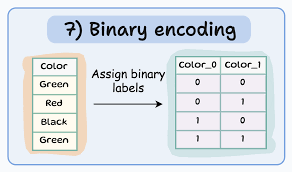A Comprehensive Guide to Binary Encoding in Data Systems 2024
Binary encoding plays a crucial role in data storage and transmission, especially for big data, distributed systems, and high-performance computing. Converting data into efficient binary formats helps reduce storage space, parsing time, and network bandwidth.
In this blog, we will explore: ✅ Why binary encoding is needed
✅ Common binary encoding formats (MessagePack, Thrift, Protocol Buffers, Apache Avro)
✅ Advantages of schema-based encoding
✅ Best practices for using binary encoding
1. Why Use Binary Encoding?

Data is often stored and transmitted in formats like JSON and XML, but these formats can be verbose. For small datasets, the difference is negligible, but for terabytes of data, choosing the right format significantly impacts performance.
🔹 Example: JSON vs. Binary Encoding A JSON document:
jsonCopyEdit{
"userName": "JohnDoe",
"favoriteNumber": 1337,
"interests": ["coding", "gaming"]
}
Encoded as MessagePack (binary format), this shrinks in size and speeds up parsing.
✅ Key Benefits of Binary Encoding:
- Smaller file size (reduced storage and network transfer time).
- Faster parsing (eliminates unnecessary whitespace and metadata).
- Optimized for big data systems (Apache Hadoop, Kafka, Spark).
🚨 Trade-off: Loses human readability compared to JSON.
2. Common Binary Encoding Formats

Several binary encoding formats exist, each with its strengths. Here’s a comparison:
| Format | Developed By | Schema Required? | Use Case |
|---|---|---|---|
| MessagePack | Open-source | No | Faster JSON alternative |
| BSON | MongoDB | No | NoSQL document storage |
| Thrift | Yes | Cross-language RPC | |
| Protocol Buffers | Yes | Efficient structured data | |
| Apache Avro | Apache Hadoop | Yes | Big data processing |
3. MessagePack: Binary Encoding for JSON

MessagePack is a lightweight binary format that maintains JSON compatibility while reducing storage size.
How It Works
- Encodes JSON-like data into a binary format.
- Uses compact data types (e.g., distinguishing integers from floating-point numbers).
- Removes the need for field name repetition.
🔹 Example: Encoding JSON into MessagePack
- JSON Document (81 bytes):jsonCopyEdit
{ "userName": "JohnDoe", "favoriteNumber": 1337 } - Encoded MessagePack (66 bytes):arduinoCopyEdit
0x83 0xa8 "userName" 0xa7 "JohnDoe" 0xa8 "favoriteNumber" 0xcd 1337
✅ Advantage: Smaller than JSON but still self-contained.
🚨 Limitation: Does not enforce schema, so field names are still included.
4. Thrift & Protocol Buffers: Efficient Binary Encoding with Schemas

To further optimize data storage, schema-based encodings like Thrift and Protocol Buffers remove field names entirely.
How They Work
- Require a predefined schema for data.
- Instead of storing field names, use numeric tags.
- Provide faster serialization and deserialization.
🔹 Example: Thrift Encoding
- JSON:jsonCopyEdit
{ "userName": "JohnDoe", "favoriteNumber": 1337, "interests": ["coding", "gaming"] } - Encoded in Thrift BinaryProtocol (59 bytes):scssCopyEdit
Field 1 (string) → "JohnDoe" Field 2 (integer) → 1337 Field 3 (list) → ["coding", "gaming"]
✅ Key Benefit: Reduces size further than MessagePack by using numeric field tags.
🚨 Challenge: Requires maintaining schema compatibility.
5. Apache Avro: Optimized for Big Data
Apache Avro is the most compact binary encoding format, specifically designed for big data processing.
How Avro Works
- Uses schemas to store only values (no field names or tags).
- Encoding simply concatenates values.
- Supports schema evolution, allowing old and new schemas to work together.
🔹 Example: Encoding in Avro
- JSON:jsonCopyEdit
{ "userName": "JohnDoe", "favoriteNumber": 1337 } - Encoded in Avro (32 bytes):arduinoCopyEdit
"JohnDoe" 1337
✅ Key Benefit: Most storage-efficient.
🚨 Limitation: Reader must have the correct schema to interpret data.
6. Schema-Based Encoding: Why It Matters
Many binary formats require a schema. While this adds some complexity, it provides several benefits:
✅ Smaller file sizes (field names are replaced with numeric tags).
✅ Faster parsing (database engines know the exact field layout).
✅ Backward compatibility (schema evolution allows changes without breaking applications).
🔹 Example: Forward & Backward Compatibility in Avro
- Writer’s schema: Includes
"favoriteColor". - Reader’s schema: Does not expect
"favoriteColor". - Avro automatically ignores unknown fields, making schema evolution seamless.
🚨 Schema Trade-off: Requires maintaining version control.
7. Choosing the Right Binary Encoding Format
| Use Case | Best Encoding Format |
|---|---|
| Faster JSON storage | MessagePack, BSON |
| Cross-language RPC | Thrift, Protocol Buffers |
| Big data processing | Apache Avro |
| Optimized NoSQL storage | BSON (MongoDB) |
✅ MessagePack – Best for general JSON-like storage.
✅ Thrift / Protocol Buffers – Ideal for structured RPC communication.
✅ Apache Avro – Perfect for Hadoop, Kafka, and distributed systems.
8. Best Practices for Using Binary Encoding
✅ Use schema-based encoding for structured data (Thrift, Protobuf, Avro).
✅ Choose Avro for big data applications (Hadoop, Spark, Kafka).
✅ Use MessagePack for compact JSON-like data storage.
✅ Avoid binary encoding for human-readable logs (use JSON instead).
✅ Ensure schema compatibility when evolving data structures.
9. Final Thoughts
Binary encoding boosts performance for data-intensive applications, making it ideal for big data, NoSQL databases, and real-time analytics. However, the choice of format depends on data structure, storage efficiency, and system compatibility.
💡 Which binary encoding format do you use in your projects? Let us know in the comments! 🚀